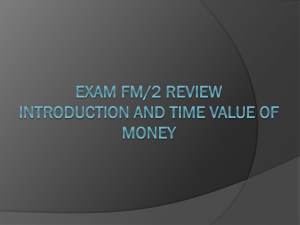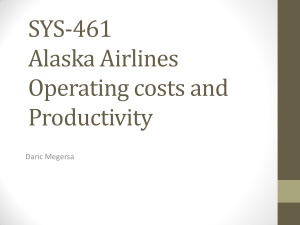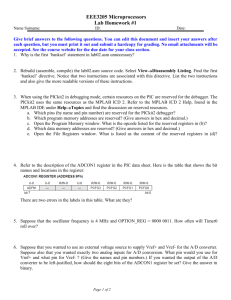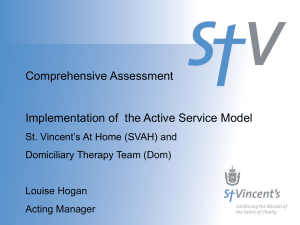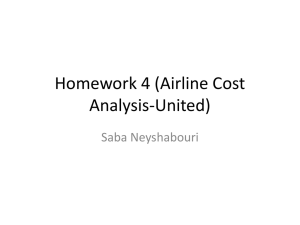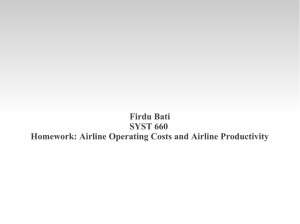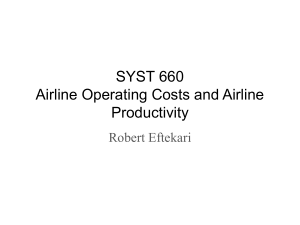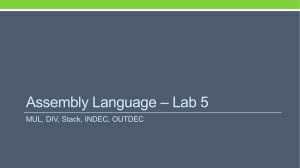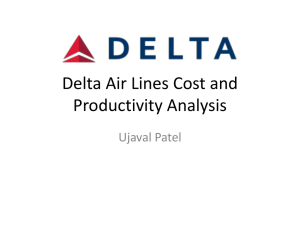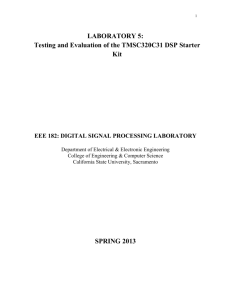slides_3e_chp6
advertisement
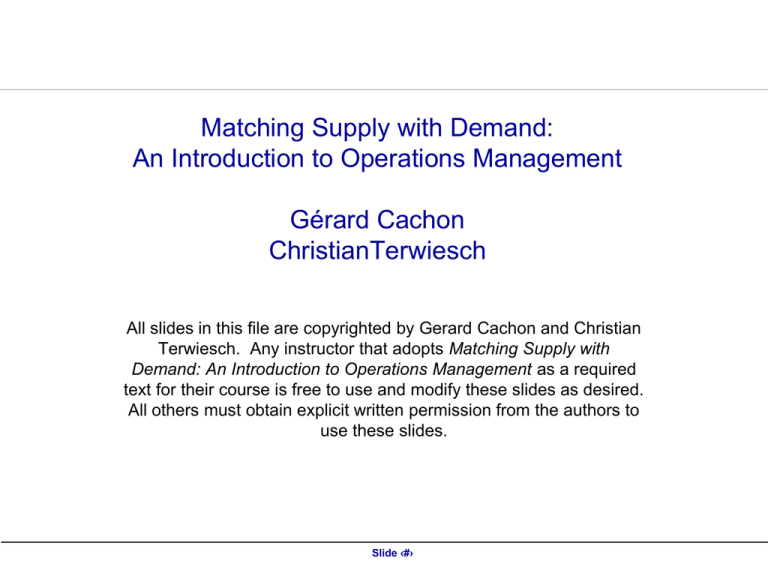
Matching Supply with Demand: An Introduction to Operations Management Gérard Cachon ChristianTerwiesch All slides in this file are copyrighted by Gerard Cachon and Christian Terwiesch. Any instructor that adopts Matching Supply with Demand: An Introduction to Operations Management as a required text for their course is free to use and modify these slides as desired. All others must obtain explicit written permission from the authors to use these slides. Slide ‹#› Link Between Operations and Finance Slide ‹#› Paul Downs started making furniture in 1986, in a small shop in Manayunk. Over the years we have outgrown 4 other shops and we now operate a 20,000 sf shop (see below) in Bridgeport, PA. Much of our work is residential, but we also do a lot of office furniture, including desks and conference tables. We complete 125 commissions per year, consisting of about 500 separate pieces of furniture. Slide ‹#› Production facility Machines valued about $350k, depreciation $60k p.a. Overall facility is utilized at 100% right now Show rooms and factory: $150k for rent Indirect costs: marketing ($100k, $180k management, $60k finish) Inventory: $50,000 WIP and $20,000 raw material Suppliers need to be paid 1 month beforeSlide receiving the wood. ‹#› Work force 12 cabinet makers each working about (220 days @8h/day) Make $20 per hour A worker needs about 40h per unit of furniture (work-cell) as labor content Spend about 15% of time on set-ups (build fixtures / program machines) Labor utilization around 90% (idle time resulting from waiting) Slide ‹#› End Product Average price is $3000 per unit Requires 30kg of wood (wood costs about $10 per kg) before scrap 25% scrap Customer pays 50% down and gets her furniture 3 months later Slide ‹#› Creating ROIC (Value, KPI) Trees Setup Volume Growth Value ROIC Labor hours Manufacturing costs per unit SG&A costs per unit WACC Training Yield Indirect labor Job Material Breaks Invested capital per unit Develop value trees Link financial measures to potential value drivers in operations In operations, performance typically focuses on ROIC Develop several versions as there is no “right answer” Explore multiple sub-trees Slide ‹#› Value Drivers Value drivers are (operational / “little”) variables in the ROIC tree that have a big impact on ROIC Identify value drivers based on sensitivity analysis in Excel Typical value drivers: -If operation currently is capacity constrained (i.e. has high demand), everything that creates additional capacity is powerful utilization / downtime production yields set-up time / other improvement of overall equipment effectiveness (OEE) -If operation currently is demand constrained (i.e. has insufficient demand), everything that gets more $’s out of a customer is powerful variety / customization after-sales service / support => innovation But: no general rule exists: your insight is needed Slide ‹#› How the Airline Industry Works: Philadelphia (PHL) to Seattle (SEA) on a Boeing 737-700 Distance: 2378 miles (nonstop) Seats on airplane: 137 Available seat miles: 137*2378=325,786 seat miles 120 passengers are on the plane paying an average of $200 for their ticket Revenue passenger miles: 120*2378=285,360 revenue passenger miles Load factor: RPM/ASM=0.876 (percentage of seats sold) Yield: revenue per revenue passenger mile=120*200/285,360=0.08 $/RPM Main cost categories are Labor expenses Fuel expenses Landing fees SGA Slide ‹#› Bottom-up / Inside-out Analysis vs Top-down / Outside-in Analysis Number of planes ASM ASM per plane RPM Load Factor Revenue Yield ($/RPM) EBIT Wages per employee Labor cost Employees per ASM ASM Cost Cost per gallon Return on Invested Capital Fuel cost Gallons per ASM ASM Other cost Other expenses per ASM ASM Capital Fixed capital Number of planes Capital per plane Other capital Working capital • Why did SouthWest do so well (to 2001)? • Pick three hypotheses and locate them in the tree (only simple tree is shown here) Slide ‹#› Using Productivity Ratios: Airline Application Revenue/Cost=Revenue/Output * Output/Capacity Operational yield * Transformation efficiency Capacity/Cost 1/unit cost of capacity Revenue / labor costs = Revenue/RPM * RPM/ASM * ASM / Employee * Employees/Labor costs USAir: 2.43 = SW : 3.31 = 0.197 * 0.70 * 0.37 * 47.35 0.135 * 0.69 * 0.53 * 67.01 Labor productivity advantage of SW is driven by (a) fewer employees per ASM and (b) lower wages Note: There exists a $25k per year difference in wages (=(1/47.35-1/67.01)*4000 ) Revenue / fuel costs = Revenue/RPM * RPM/ASM * ASM/Gallons * Gallons/fuel costs USAir: 6.21 = SW : 3.31 = Fuel productivity advantage of SW is driven by (a) fewer gallons per ASM and (b) cheaper fuel 0.197 * 0.70 * 52.3 * 0.86 0.135 * 0.69 * 60.2 * 1.21 Note: There exists a $0.33 per gallon difference in fuel prices (=(1/0.86 – 1/1.21)) Slide ‹#› Sizing the Pie: How to Value the Financial Performance Improvement From an Improved Productivity Ratio Cost reduction required to break even $2,444M $284M Cost reduction required to become SW profitable Current (2000) USAir Savings in wages if SW OpsExpense at 17212 ASMwage rate is paid $198M $108M Savings in wages if SW productivity is achieved Savings in fuel if SW fuel prices are paid Slide ‹#› $35M Savings in fuel if SW efficiency is achieved $1,804M New Ops expense Strategic Trade-offs Yield vs efficiency (2000) 0.245 0.245 0.225 0.205 0.185 Lufthansa 0.165 USAir 0.145 Ryanair Delta United Airlines Continental NorthWest 0.125 SouthWest Yield (passenger revenue/RPM) 0.225 Yield (passenger revenue/RPM) Yield vs efficiency (2008) Lufthansa 0.205 0.185 0.165 American Airlines United Airlines 0.145 Continental SouthWest USAir 0.125 NorthWest 0.105 0.105 0.085 0.085 Delta Ryanair 2 7 Efficiency (ASM/Op cost) 12 2 7 Efficiency (ASM/Op cost) 12 No differentiation between the major US carriers Efficient frontier: Southwest introduced the high efficiency strategy in the US Ryanair has pushed this to the extreme in Europe following => Choose clean strategies, especially for Lufthansa and Ryanair … … and drive improvement towards the frontier and beyond Slide ‹#› Note: all numbers are exchange rate adjusted
